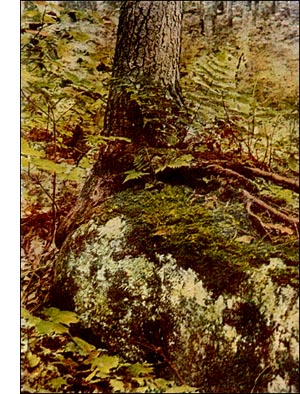Genus Marchantia
 Genus MARCHANTIA, (L.)
Genus MARCHANTIA, (L.)Marchantia polymorpha (See Colour Plate XIII) is a good example of a thalloid form, and from it one may learn, without a microscope, the principal parts.
The plant itself lies fiat upon the earth and has a distinct upper and lower tissue. The lower tissue develops short root-like hairs which serve to anchor the plant. The upper tissue appears as if marked off into small rhomboidal spaces in the centre of each of which a pore may be seen.
Little cups are often present on the upper surface, with green disks (gemmae) in them. Upright umbrella-like growths on which are borne the male and female organs are found also on the upper surface.
The male peduncle is capped with a flat, slightly lobed receptacle. The female peduncle is capped with a receptacle bordered with deep finger-like lobes. The male organs (antheridia) are developed in the upper surface of the scalloped receptacle.
The female organs (archegonia) are developed on the under Surface of the receptacle bearing the finger-like lobes. Spore-cases filled with spores and spirally twisted threads (elaters) later occupy the place of the archegonia between the long lobes.
A veil (calyptra) surrounds the spore-case. A false perianth surrounds the veil. A fringed covering (involucre) encloses all the spore-cases between two lobes. When the spore-case is mature, it bursts irregularly for the scattering of the spores. The spore germinates to form one cell or a small group of cells (protonema) from which later will be developed the plant already described.
Marchantia Polymorpha Liverwort